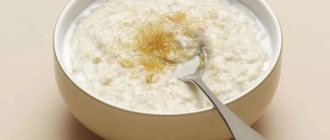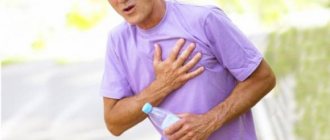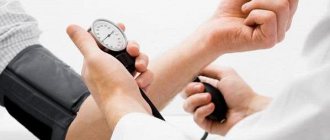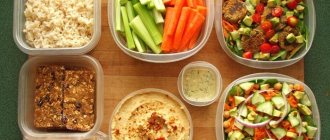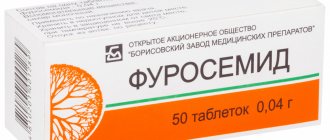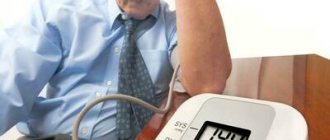Hypertensive crises are an exacerbation of hypertension, characterized by excessive stimulation of the nervous system, spasm of cerebral vessels and pain in the heart. In this condition, a person’s blood pressure rises sharply and there is a risk of a heart attack.
Stress and inherited genes are the main causes of the “epidemic” of hypertension.
According to statistics, every third person has experienced an uncomplicated crisis. After an exacerbation, it is imperative to monitor your nutrition and follow a diet.
Dietary recommendations
Recommendations for nutrition after a hypertensive crisis should be made by a cardiologist. The specialist focuses on indicators of blood tests, urine tests, ultrasound and cardiogram.
A diet during a hypertensive crisis helps to normalize blood pressure, preventing heart attack and stroke.
The menu must be carefully thought out:
It is necessary to exclude foods that lead to flatulence and bloating. Avoid salty and spicy foods. Do not drink a lot of carbonated water and coffee. Eliminate fatty meats from your diet. You can eat fresh fruits, boiled and raw vegetables, water porridge, and lean fish.
It is very important to monitor the amount of table salt in your food.
It is best to abandon it altogether or keep it to a minimum. Instead, add garlic and dietary spices. Before going to bed, you should not load your stomach with food. Eat small portions, but at least five times a day.
Rosehip to the rescue
For drinks, you should definitely drink rosehip infusions. It is best to take it before bed.
In combination with diet and medications, this is an excellent adjuvant that helps normalize blood pressure.
Rose hip decoction is prepared as follows. A small amount of berries is poured with boiling water, brought to a boil and left for about twenty minutes. You cannot boil for a long time, otherwise the berries will lose their healing properties. You can also pour the fruits overnight and leave them in a thermos until the morning. In the morning, the infusion must be heated.
It is very good to add other components to the decoction: aloe, pine needles, onion, hawthorn, chokeberry.
Diet No. 10
For hypertension, you need to pay attention to diet No. 10. It excludes the use of table salt, which retains fluid and causes swelling. Reduces the amount of liquid you drink per day to a liter.
Products must contain polyunsaturated acids (seafood, fish). Also, after a crisis, the stomach needs to be unloaded and during these days you need to eat fruits, vegetables, as well as some cereals.
This diet for high blood pressure is often prescribed in hospitals to patients with high blood pressure.
Diet for hypertension
Doctor - cardiologist of the cardiology department No. 2 Seliverstova I. V.
Hypertension is a disease of the cardiovascular system, which manifests itself in increased blood pressure and may be accompanied by atherosclerosis.
Having appeared once, hypertension persists throughout life, although it may not appear outwardly for a long time. Lack of treatment leads to various heart diseases and stroke. You can regulate your blood pressure by watching your weight, exercising, eating healthy and nutritious foods, limiting your alcohol and cigarette consumption, and taking medications as prescribed by your doctor.
is especially important for hypertension
if an overweight person suffers from high blood pressure. According to medical research, every kilogram of excess weight increases blood pressure by 1 mmHg. Therefore, proper dietary nutrition in this case should not only normalize blood pressure, but also contribute to weight loss. Fasting and strict diets are contraindicated for hypertensive patients; the main focus is on reducing calorie intake by reducing fat content.
Diet for hypertension: products
A diet for hypertension excludes the following foods
:
- products with a high caffeine content (coffee, strong tea);
- spicy, salty foods, smoked foods, spicy dishes;
- foods high in fat, offal;
- cakes, pastries with butter cream;
- alcoholic drinks
Table salt is the number one enemy of hypertensive patients. People suffering from high blood pressure can consume no more than 5 g of salt per day, and in case of exacerbation, eliminate it from the diet altogether. At least a third of the fat consumed by hypertensive patients should be vegetable oils; the recommended daily fluid intake is 1-1.2 liters per day.
Diet for hypertension
must necessarily include products:
- lean varieties of fish and meat;
- milk and fermented milk products (low-fat);
- millet, buckwheat, oatmeal;
- soups (mostly vegetarian, dairy and fruit);
- fruits and vegetables, raw and cooked;
- foods rich in magnesium and potassium (apricots, dried apricots, apples)
As an exception, it is allowed to prepare soups based on lean meat twice a week. Garlic is a very good preventative against hypertension; it can be used in food in any form - raw, dried and pickled. It helps remove cholesterol from the body, improves the functioning of the digestive system and heart. A diet for hypertension must include lemons and grapefruits - vitamin C, contained in citrus fruits, strengthens the walls of blood vessels. Drinking fresh vegetable juices, especially carrots and spinach, also serves as an excellent preventative and therapeutic agent.
An important condition for the nutrition of hypertensive patients is moderation in food. Food consumed during the day should be divided into 5-6 meals; dinner should be light and no later than two hours before bedtime. The need for sweet dishes can be satisfied with fruit creams, jelly, jellies and berry compotes. Raw juices, decoctions of wheat bran and rose hips are perfect as vitamin supplements.
Diet for hypertension, recipes
When preparing dietary dishes, it is important to follow the basic nutritional rules mentioned above: avoid fatty foods, preservatives, spices, and large amounts of salt. The women's website JustLady will give you several recipes and recommendations, based on which you can independently develop a healthy and tasty menu.
1. Light fish soup. Bring 2 liters of water to a boil, add diced potatoes, onions, carrots and washed rice into the pan, cook for 20 minutes. Mash a can of canned saury or mackerel in its own juice with a fork, add to the pan, and cook for another 10 minutes. At the very end, put a bay leaf in the soup and pour in 3-4 liters. vegetable oil.
2. Chicken soup. For it you will need 300 g of skinless chicken breasts, potatoes, carrots, onions and buckwheat. Pour 2 liters of water into a saucepan, bring to a boil and add diced or stripped vegetables and washed buckwheat into it. Cut the chicken breast into large pieces, lightly fry in vegetable oil and add to the pan. Cook until done, sprinkle with herbs.
3. Vegetarian borscht. Sliced vegetables: beets, potatoes, carrots, onions, cabbage, simmer with vegetable oil in a deep frying pan until half cooked, add tomato and fill with water. Cook for 15 minutes over low heat, add finely chopped garlic and herbs. Before serving, you can add a slice of lemon to each plate.
4. Vegetable salads. Here your imagination knows no limits. You can use any vegetables as a base; use vegetable oil, lemon juice and low-fat yogurt as a dressing. But such a healthy and, most importantly, delicious salad is perfect for the holiday table. It does not violate the diet for hypertension , contains only natural products. Grate the radish on a coarse grater, add a finely chopped egg. Cut the chicken fillet into small cubes, chop the onion and fry together with the chicken in vegetable oil. Place the onion and chicken in a salad bowl with radish and egg, stir. Bon appetit!
5. Delicious desserts. The basis of sweet dishes should be berries and fruits. They are used to make purees, jelly, jellies and compotes. You can add dried apricots, raisins, nuts and seeds to fresh berries and fruits. Even if you are on a high blood pressure diet, recipes may contain small amounts of sugar. Therefore, use our recipe and treat yourself to delicious jam that can be prepared in 6 minutes. Take any fruits or berries (large ones must be chopped), add a small amount of sugar and place in the microwave for 5-8 minutes. Stir the fruit every 3 minutes. Fragrant, healthy jam without preservatives and with a small amount of carbohydrates is ready - set the table and brew tea!
Prohibited products
Many people neglect dietary restrictions, and in the meantime, toxins and waste accumulate in their bodies.
Foods that should not be consumed if you have high blood pressure:
- Desserts with cream;
- Strongly brewed tea, caffeine, alcohol;
- Fatty meats;
- Canned food;
- Pastries, bread;
- Dairy products should also be excluded;
- Pasta and semolina are not recommended for cereals;
- It is better to reduce chocolate, ice cream, and sugar consumption to a minimum or eliminate it;
- Sauces (including mayonnaise and mustard)
- Fatty broths;
- Mushrooms;
- Grape;
- Radish and radish;
- Legumes are not completely excluded, but are reduced to a minimum;
- Smoked meats
You need to know that your diet should not contain a lot of carbohydrates and fats. Hypertensive patients should completely avoid spicy and salty foods.
Healthy foods
What foods can and should be eaten to maintain health after complications and high blood pressure?
- Cereals;
- Light vegetable soups without potatoes or with a small addition of them;
- Muesli;
- Light grains: buckwheat, millet, pearl barley, rice.
- Egg white;
- Natural yoghurts without additives or flavorings, kefir.
- From meat - chicken and turkey, boiled or steamed.;
- Slightly dry bread;
- Dried fruits, compote, jelly;
- Weak tea;
- The fruits of hawthorn and rose hips.
Speaking about hawthorn, it is necessary to note its beneficial properties for the cardiovascular system. It strengthens the heart muscle and helps avoid various heart diseases.
Also, teas and decoctions with the addition of dried plants are used to lower cholesterol, treat arrhythmia, eliminate insomnia and reduce fatigue and stress.
Sample menu after the crisis
Only a balanced diet can help improve your condition! Allows you to reduce blood pressure and reduce the risk of re-exacerbation.
A diet after a hypertensive crisis will help cleanse the body of toxins and harmful toxins.
All products must be fresh. It is recommended to add greens, herbal infusions and teas (rose hips, chamomile) to the main diet. You can use sour cream or natural unsweetened yogurt as a salad dressing.
Sample menu after a hypertensive crisis:
First option
| Breakfast | Oatmeal with fruits: banana, apple, peach. Green tea |
| Lunch | Baked apples with honey |
| Dinner | Buckwheat with stewed vegetables (zucchini, carrots, onions, broccoli) Fish Kissel |
| Afternoon snack | A handful of dried apricots |
| Dinner | Light chicken cutlets (steamed or stewed) or baked fish Rose hip broth |
Second option
| Breakfast | Freshly squeezed juice Muesli |
| Lunch | Natural yogurt without additives |
| Dinner | Vegetable soup, a piece of dried bread Kompot |
| Afternoon snack | Banana |
| Dinner | Light pilaf with vegetables (rice should be long grain) or fish Kefir |
Third option
| Breakfast | Fruit salad with yoghurt dressing Weak tea |
| Lunch | Apple |
| Dinner | Wheat porridge with pumpkin, a piece of fish Freshly squeezed fruit juice |
| Afternoon snack | Handful of nuts |
| Dinner | Broccoli soup puree Rosehip infusion |
Fourth option
| Breakfast | Cottage cheese with honey Mors |
| Lunch | Yogurt |
| Dinner | Steamed vegetable cutlets, beetroot soup Green tea |
| Afternoon snack | Jelly with fruits |
| Dinner | Boiled fish, light salad Compote |
For hypertensive patients, it is useful to prepare fish soup, baked potatoes, casserole (especially cottage cheese and pumpkin), cottage cheese soufflé as a dessert, vinaigrette, baked fish, vegetable stew.
A balanced diet and limiting fatty, salty foods and carbohydrates will help normalize blood pressure in 80% of cases.
Hypertensive crisis
What is a hypertensive crisis and how does it manifest?
A hypertensive crisis is a sharp increase in blood pressure lasting from several hours to several days.
It is manifested by a sharp deterioration in health: the appearance of headache, nausea, vomiting, pain in the heart. A crisis is often accompanied by dizziness, flashing “spots”, numbness of the tongue, lips, face and hands; You may also experience weakness in the legs. The outcome of a hypertensive crisis can be a myocardial infarction or stroke - formidable, dangerous conditions that cannot be allowed to happen!
Factors provoking hypertensive crisis:
- Psycho-emotional and physical stress.
- Stopping or irregularly taking antihypertensive (blood pressure-lowering) drugs.
- Excessive consumption of table salt and liquid.
- Alcohol abuse (drinkers suffer from blood pressure 2 times more often than non-drinkers), tobacco smoking (one cigarette causes blood pressure to rise to 30 mm Hg).
- Excess body weight (an extra kilogram of weight increases blood pressure by 1-3 mmHg).
- Sedentary lifestyle.
- Changes in atmospheric pressure, weather dependence.
Optimal blood pressure should be no more than 120/80 mmHg. Normal blood pressure is 130/80mmHg. Blood pressure is considered borderline - 130-139 / 80-89 mm Hg. Blood pressure is above 140/90mmHg. considered arterial hypertension!
What to do if there is a sudden rise in blood pressure
If your blood pressure has risen, give yourself self-help:
- Take the fast-acting drug captopril (25-50 mg) under the tongue, chew and dissolve until completely dissolved.
- Take a comfortable position, preferably horizontal.
- After 30 min. re-measure your blood pressure. If there is no change, repeat captopril.
- If blood pressure decreased by 20 mm Hg. or more, continue (or resume) the antihypertensive therapy prescribed by your doctor.
- The pressure should be reduced gradually over 1 hour.
- It is necessary to have medications on hand in case of unexpected increases in blood pressure (for example, captopril).
- If the rise in pressure is excessive (over 200/100 mmHg) or is accompanied by the appearance of chest pain, increased headaches, or the appearance of weakness in the limbs, speech impairment, call a doctor at home.
But now the attack has passed, the pressure has been reduced, the patient is not in danger of complications, but the fear and anxiety do not go away... Often a person, especially a lonely person, fears that after the ambulance leaves he will feel ill again and is nervous. Therefore, after a crisis, it is necessary to take any sedative (calming) agent (Corvalol, valerian infusion) and try to fall asleep. Sedatives will help relieve anxiety and avoid insomnia, which in itself can lead to a new increase in blood pressure.
How to avoid a recurrence of a hypertensive crisis
To avoid a recurrence of a hypertensive crisis, you must:
- Measure your blood pressure regularly.
- Take antihypertensive medications regularly.
- Always have a quick-acting drug (captopril) with you.
- Eat small meals. At breakfast before work, it is recommended to eat about 30% of the total daily amount of food, for second breakfast - 20%, lunch - 40%, dinner no more than 10%. Dinner should be no later than 2 hours before bedtime.
- Consume no more than 4-5 g of table salt per day (replace salt with spices, do not add salt to the food on the plate). It is better to avoid eating salty foods such as chips, salted crackers, nuts, soy sauce, smoked meats, and canned foods.
- Eat more vegetables and fruits.
- Do not overeat, especially high-calorie foods (animal fats, fatty meats, sweets, potatoes, flour products).
- Know the optimal weight for your age and gender.
- Avoid excessive consumption of alcoholic beverages.
- Stop smoking.
- Increase daily physical activity.
- Easily mastered mental regulation skills (relaxation and breathing exercises, autogenic training) will help to achieve a reduction in the level of psycho-emotional tension (stress).
- Keep a diary of blood pressure control in the form: Date / Time of day / Blood pressure / Pulse / Notes
Remember! Following these recommendations will teach you to control your illness and live an active, fulfilling life!
Authors: Sharanova O.A. – Deputy Chief Physician of the State Emergency Medical Service V.V. Veselov – doctor of the State Medical Emergency Service
Prevention methods
And as a preventive measure to prevent hypertensive crises, it is necessary:
- follow diet number 10;
- avoid overexertion, fatigue, stressful situations;
- give up cigarettes and alcohol;
- temper yourself and do daily exercises.
- perform exercises from the exercise therapy system.
Only complex therapy and compliance with all recommendations will help restore the proper functioning of the cardiovascular system.
Proper nutrition and diet after a hypertensive crisis is a whole range of measures.
If the patient finds it difficult to create his own regimen, it is better to consult a general practitioner for help. Author of the article Svetlana Anatolyevna Ivanova, general practitioner
All about hypertension
Diet for hypertension
The activity of the cardiovascular system is closely related to the processes of digestion. When you overeat, the stomach moves the diaphragm upward, making it difficult for the heart muscle to contract. Excess fluid in the body creates additional stress on the heart.
Excessive consumption of table salt leads to water retention in the body, which contributes to increased blood pressure and swelling.
The right approach to your daily diet
will definitely help hypertensive patients
Principles of diet for stage 2 hypertension
The diet is based on limiting the intake of liquid and table salt, eliminating foods and dishes that increase cholesterol levels and contribute to the development of obesity. Rational nutrition plays a big role in the life of a person suffering from hypertension. Overeating, drinking alcohol. Prohibited foods in themselves can lead to the development of a hypertensive crisis.
Following a diet for stage 2 hypertension,
you should limit your consumption of foods
- Salt. It is recommended to limit salt intake: no more than 5 grams per day. To do this, it is better to add salt to already prepared dishes. It may be advisable to use a special “Prophylactic” salt with a reduced content of sodium ions. They are replaced with beneficial ions of potassium, magnesium and iodine. Most natural products: meat, fish, cottage cheese, vegetables, fruits contain significantly less sodium than ready-made gastronomic products.
- Liquid. It is necessary to limit fluid intake so as not to impede the functioning of the cardiovascular system.
- Tonic drinks. Tea, coffee and other drinks containing caffeine can cause heart palpitations and increase blood pressure.
- Consumption of fats of animal origin. A large amount of fat in the diet contributes to the development of vascular atherosclerosis, which, in turn, predisposes to the development of hypertension.
- Sugar. It also contributes to the development of atherosclerosis.
- Easily digestible carbohydrates. With hypertension, it is important to prevent the development of obesity, which contributes to the progression of the disease.
- Alcoholic drinks in large quantities. It is recommended to drink dry red wine.
If you have hypertension, you should increase your intake of:
- Potassium. The most important aspect of the diet for hypertension is increasing potassium intake. It promotes the removal of fluid from the body, having a mild diuretic effect, improves heart function, and increases the resistance of the heart muscle to oxygen starvation.
- Magnesium. It has a vasodilating effect and is involved in the prevention of vasospasm.
- Iodine. Participates in metabolism and is important for the prevention of atherosclerosis.
Diet for hypertension: menu
Cereals, fish, dairy products and fruits are the best choice for a healthy person
Experts rightly argue that treatment of hypertension, like any other disease, should be done comprehensively - it is in this case that the results will be the most noticeable and positive. A diet for stage 2 hypertension, as well as moderate exercise, will give better results than simply taking pills and medications. We bring to your attention main dishes that are useful for hypertension of any degree.
- Cereals. Crumbly porridge with water or milk: oatmeal, buckwheat, millet. It is advisable to consume boiled pasta no more than a couple of times a week.
- Soups. Vegetarian vegetable soups with the addition of various cereals, beetroot soup, dairy and fruit soups are recommended. Avoid concentrated meat, fish and mushroom broths.
- Bread. Slightly dried, from first and second grade flour. Exclude fresh bread, baked goods, pancakes.
- Meat. Lean varieties of beef, pork, chicken, turkey, and rabbit are healthy. It is better to eat meat boiled or baked. Exclude fatty meats and poultry, offal, sausages, and canned food.
- Fish. Low-fat fish and seafood. Exclude salted, smoked fish, canned food.
- Dairy products. Milk, fermented milk products, cottage cheese. Avoid fatty and spicy cheeses.
- Vegetables are recommended fresh, boiled, baked, vinaigrette, salads with vegetable oil. Limit the consumption of cabbage, green peas, and mushrooms. Avoid pickles and marinades, sauerkraut, and do not consume radishes, onions, or sorrel as vegetables.
- Fruits, sweets. Fresh fruits and berries, dried fruits, jelly, compotes, honey, jam. Limit chocolate and candy.
- Beverages. Fruit and vegetable juices, fruit drinks, weak tea, cocoa, natural coffee, coffee drinks. Eliminate instant coffee.
Diet for hypertension: menu for the day
A sample menu for the day includes all the necessary products for patients suffering from arterial hypertension of any degree.
Breakfast: Buckwheat porridge with milk
Second breakfast: Baked apples
Lunch: Vegetable soup with sour cream, beef stroganoff with a side dish of boiled potatoes, dried fruit compote
Afternoon snack: Dried apricots
Dinner: Baked carrot and apple balls
At night: Rosehip decoction
In the next articles of this series, we will tell you about recipes for dishes recommended for hypertension, as well as a diet for hypertension for a week.
Stay with us and be healthy!
